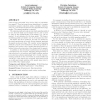Free Online Productivity Tools
i2Speak
i2Symbol
i2OCR
iTex2Img
iWeb2Print
iWeb2Shot
i2Type
iPdf2Split
iPdf2Merge
i2Bopomofo
i2Arabic
i2Style
i2Image
i2PDF
iLatex2Rtf
Sci2ools
KDD
2006
ACM
2006
ACM
Sampling from large graphs
Given a huge real graph, how can we derive a representative sample? There are many known algorithms to compute interesting measures (shortest paths, centrality, betweenness, etc.), but several of them become impractical for large graphs. Thus graph sampling is essential. The natural questions to ask are (a) which sampling method to use, (b) how small can the sample size be, and (c) how to scale up the measurements of the sample (e.g., the diameter), to get estimates for the large graph. The deeper, underlying question is subtle: how do we measure success? We answer the above questions, and test our answers by thorough experiments on several, diverse datasets, spanning thousands nodes and edges. We consider several sampling methods, propose novel methods to check the goodness of sampling, and develop a set of scaling laws that describe relations between the properties of the original and the sample. In addition to the theoretical contributions, the practical conclusions from our work a...
| Added | 30 Nov 2009 |
| Updated | 30 Nov 2009 |
| Type | Conference |
| Year | 2006 |
| Where | KDD |
| Authors | Jure Leskovec, Christos Faloutsos |
Comments (0)

